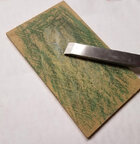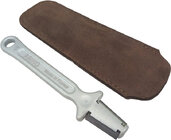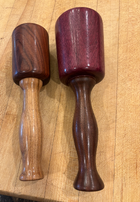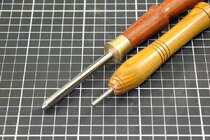I got a lesson today from Gerald Lawrence today. He kindly came over and demonstrated and had me repeat the process on using a skew which is the one tool that I NEEDED a lesson on. It went well except on turning a bead which will take practice on my part.
Sounds like you had an incredible session. (Hey, I wondered about the avitar photo too!)
Numerous experts, including Richard Raffan, say spindle turning (with skew, spindle gouge, etc) is key to quickly developing fine tool control. Unfortunately, spindles often take a back seat to bowls and hollow forms.
I think learning the skew is so important it's the first tool I put in the hands of a beginner, even someone who has never seen a lathe before. (also for long-time turners who never used the skew or gave up after a bad experience) I start by turning the lathe by hand until they get the feel for the edge - very quickly are ready to practice planing cuts with the lathe at speed. (I sometimes start with a skew with a slightly larger included angle - a bit more forgiving.) With dozens of people so far, I've not once had someone get a catch! (finger's crossed!)
Raffan said he prefers a curved skew edge and I do that for some skews. However I prefer a straight edge for some things (thin spindles, v-cuts, facing cuts.) Raffan pointed out that making the beginning of the curve nearly horizontal at the long point will make some peeling cuts easier. Beads are difficult but a little easier with the curved edge. Deep v-cuts and facing cuts can also be tricky since the side clearance is critical to cut cleanly without a catch. I made a huge model of a skew with a piece of wood board and made a large-diameter spindle to better show the tool presentation and some of the cuts.
Thin spindles can also be challenging since they can easily flex. If interested, I posted my document on turning thin spindles in the Tutorials and Tips section here.
I sharpen skews on a 600 grit CBN and remove the tiny grinding burr. Years ago I started using these both for initial stropping and to "refresh" the edge of skews a few times before touching up with a diamond hone or going back to the grinder:

I resaw a piece of MDF on the bandsaw, leaving the sides rough. Rub a stick of polishing compound (any kind) into the surface, then hold the skew at the slightest angle and draw the tool down while pressing firmly - black marks on the surface show steel is being removed. Leaves a nicely polished edge.
As for putting a burr on scrapers, after using carbide rods in turned handles for a couple of decades, I discovered the French-made Arno burnisher:

Wow! I like the round carbide rod on one side, the triangular carbide on the other (with a very small polished radius), the angles, and the handle. These were difficult to find for a long time so when Amazon started carrying them I bought a second for "just-in-case", as in just in case I misplace the one I've had for years or give it away in a weak moment! I use this to burnish a burr on all scrapers: conventional cabinet scrapers for flat work, the curved hand scrapers I make to smooth turnings (almost always with the lathe off), and conventional and NRS scrapers for the lathe. Those without a good burnisher might consider an Arno.
Oops, sorry, I got carried away again...
JKJ




